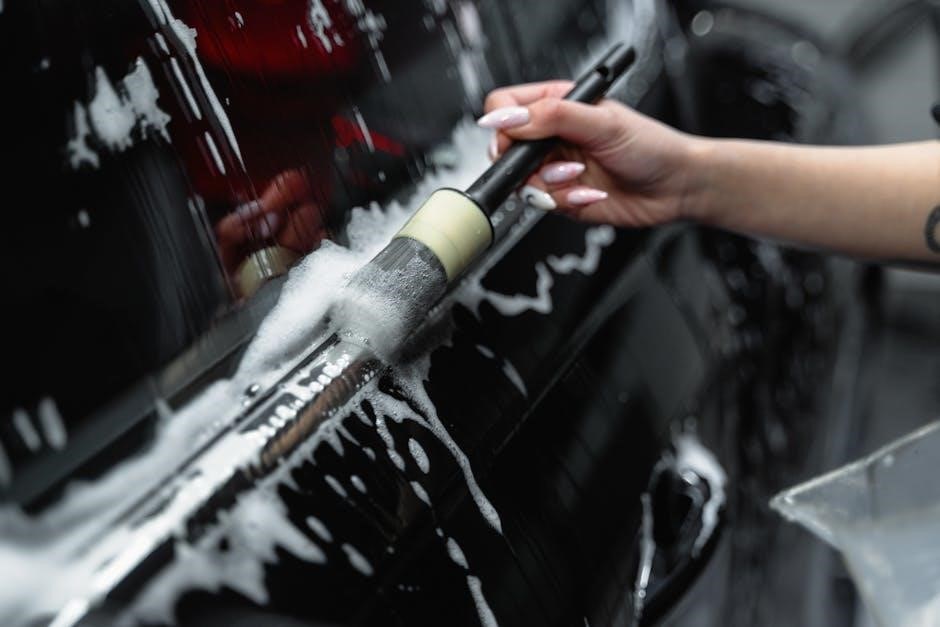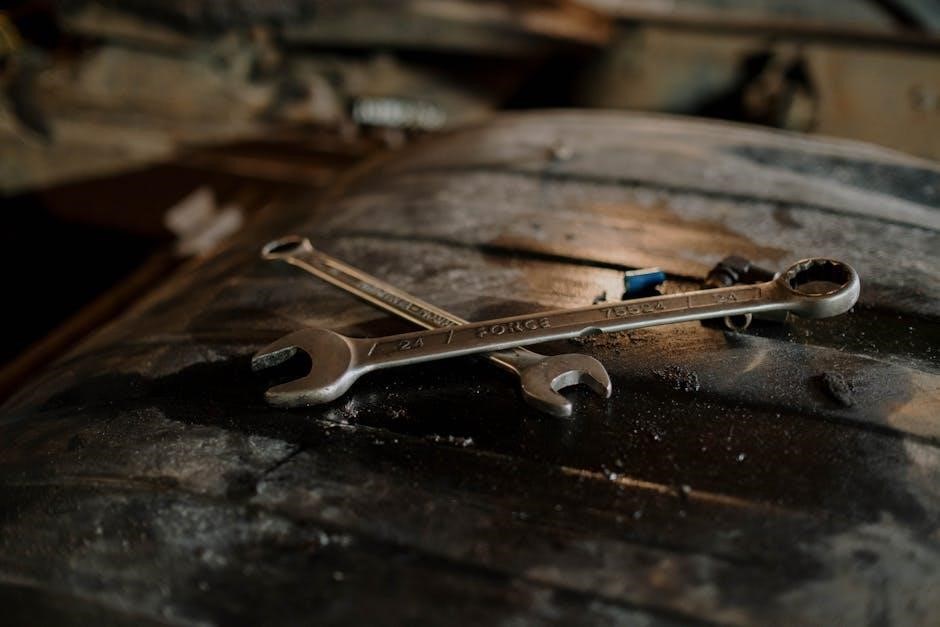A car maintenance checklist is a essential tool for ensuring vehicle longevity and safety. It outlines routine tasks to monitor and maintain your car’s performance effectively.

Why Car Maintenance Checklists Are Important
Car maintenance checklists are crucial for ensuring your vehicle operates safely and efficiently. They help identify potential issues early, preventing costly repairs and breakdowns. Regular checks improve fuel efficiency, extend the lifespan of components, and enhance overall performance. A well-structured checklist also ensures consistency in maintenance tasks, reducing the risk of overlooked critical inspections. By following a checklist, you can avoid unexpected failures, stay proactive about your car’s health, and maintain its value over time.
Benefits of Using a Car Maintenance Checklist PDF
Using a car maintenance checklist PDF offers numerous advantages, including organization, accessibility, and cost-effectiveness. It provides a structured format for tracking essential tasks, ensuring no critical inspections are missed. The PDF can be easily downloaded, printed, and shared, making it a practical tool for both personal and professional use. Its user-friendly design allows for seamless updates and record-keeping, helping you maintain your vehicle’s health and extend its lifespan. Additionally, it serves as a valuable resource for staying proactive about your car’s maintenance needs.

Essential Items in a Car Maintenance Checklist
A comprehensive checklist includes oil and fluid levels, tire pressure, brake condition, battery health, belts, hoses, filters, and lights. Regular checks ensure optimal vehicle performance and safety.
Oil and Fluid Levels
Regularly checking oil and fluid levels is crucial for engine health. Engine oil, coolant, brake fluid, and power steering fluid must be at recommended levels. Low levels can cause overheating or damage. Use a dipstick for oil and consult your manual for fluid locations. Check fluids monthly or before long trips. Dirty or leaking fluids may indicate issues. Always use the correct type of fluid for your vehicle to avoid compatibility problems. Neglecting fluid checks can lead to costly repairs or even engine failure.
Tire Pressure and Condition
Checking tire pressure monthly ensures optimal performance and safety. Underinflated tires can lead to uneven wear, reduced fuel efficiency, and increased risk of blowouts. Always use the pressure recommended in your owner’s manual. Inspect tires for signs of wear, such as cracks, bulges, or uneven tread. Rotate tires every 5,000 to 8,000 miles to extend their lifespan. Proper tire maintenance enhances handling, improves safety, and prevents costly repairs. Keep a tire pressure gauge handy for quick checks before long drives.
Brake System Inspection
Inspecting the brake system ensures safety and prevents costly repairs. Check brake pads for wear, ensuring they exceed the minimum thickness specified by your manufacturer. Examine rotors for warping or excessive wear. Test brake fluid levels and look for signs of leaks or contamination. Inspect brake hoses for cracks or damage. Replace worn or damaged components promptly. Schedule professional inspections every 10,000 to 15,000 miles. Addressing brake issues early prevents spongy pedals, reduced stopping power, or potential failures, ensuring reliable braking performance and safety on the road.
Battery and Electrical Components
Inspecting the battery and electrical components is crucial for reliable vehicle operation. Check battery terminals for corrosion, ensuring they are clean and securely connected. Test the battery’s health using a multimeter or a professional tool to verify its charge level and condition. Examine the alternator belt for wear or cracks. Ensure all electrical connections, including fuses and relays, are intact and functioning properly. Look for signs of electrical issues, such as dimming lights or malfunctioning accessories, and address them promptly to prevent system failures.
Belts and Hoses
Inspecting belts and hoses is vital for preventing engine damage. Check the serpentine belt for cracks, frays, or wear, and ensure proper tension. Replace it if damaged or at the recommended interval. Examine coolant hoses for leaks, soft spots, or cracks. Inspect the timing belt for wear and replace it at the specified mileage to avoid costly engine damage. Regular checks help prevent breakdowns and ensure smooth engine operation. Use a checklist to track inspections and replacements for optimal maintenance.
Filters (Air, Oil, and Fuel)
Regular inspection and replacement of air, oil, and fuel filters are essential for optimal engine performance. The air filter ensures clean air enters the engine, improving fuel efficiency and reducing emissions. The oil filter traps contaminants, protecting the engine from damage. The fuel filter prevents debris from reaching the engine, maintaining fuel flow and performance. Replace these filters at intervals recommended by your vehicle’s manufacturer to avoid decreased efficiency or potential engine damage. A well-maintained filtration system is crucial for longevity and reliability.

Vehicle-Specific Maintenance Considerations
Vehicle-specific maintenance varies by make, model, and usage. High-mileage cars, trucks, and luxury vehicles require tailored checks. Always consult your owner’s manual for personalized recommendations.
Differences Between Car and Truck Maintenance
Car and truck maintenance differ due to design and usage. Trucks, often used for heavy-duty tasks, require more robust inspections of engines, transmissions, and brakes.
Truck tires need higher pressure checks and load capacity assessments, while cars focus on passenger comfort and efficiency.
Truck suspension and braking systems are heavier-duty, and their maintenance is more complex;
Regular checks for trucks include differential and chassis inspections, which are less critical for cars.
Understanding these differences ensures proper care tailored to each vehicle type.
Special Requirements for High-Mileage Vehicles
High-mileage vehicles require specialized attention to maintain performance and longevity. Beyond routine checks, focus on wear-prone components like belts, hoses, and suspension systems.
Regular oil changes and fluid flushes are crucial to prevent engine wear.
Inspect the battery and electrical systems more frequently due to increased usage.
Tires should be checked for uneven wear, and brakes need thorough inspection.
Monitor coolant and transmission fluid levels closely.
Addressing these areas helps prevent costly repairs and keeps high-mileage vehicles running smoothly.

How to Use a Car Maintenance Checklist Effectively
Use a car maintenance checklist by following a consistent schedule, adhering to recommended frequencies, and thoroughly inspecting each component to ensure reliability and safety.
Frequency of Checks
Regular checks are crucial for maintaining vehicle health. Fluid levels and tire pressure should be inspected monthly or before long trips. Oil changes are typically needed every 5,000 to 7,500 miles, while brake pads and belts should be checked every 10,000 to 15,000 miles. Tire rotations are recommended every 6,000 to 8,000 miles, and battery health should be tested annually or every 50,000 miles. Adjust frequencies based on driving conditions and manufacturer guidelines to ensure optimal performance and longevity.

Recording and Tracking Maintenance
Keeping detailed records of your car’s maintenance is vital for tracking its condition and ensuring longevity. Use a car maintenance checklist PDF to document inspections, repairs, and replacements. Include dates, mileage, and notes on any issues found. This helps identify patterns and plan future services. Store both physical and digital copies for easy access. Regularly updating these records ensures you stay organized and never miss critical maintenance tasks, ultimately saving time and money over the life of your vehicle.

Common Mistakes to Avoid When Using a Checklist
Consistently documenting your car’s maintenance is crucial for monitoring its health and planning future services. A car maintenance checklist PDF helps track inspections, repairs, and replacements by including dates, mileage, and notes on issues. This creates a clear history, helping identify trends and prevent overlooked tasks. Maintain both physical and digital copies for easy reference. Regular updates ensure organization and accountability, preventing critical maintenance from being missed. This practice not only extends your vehicle’s lifespan but also enhances its reliability and performance over time.

Troubleshooting Tips Based on Checklist Findings
When using a car maintenance checklist, identify issues early to prevent major repairs. If low oil levels are found, top them up immediately. For worn tires, check pressure and consider replacement. Faulty brakes require urgent attention, as they compromise safety. Strange noises or vibrations? Inspect suspension and alignment. Addressing these issues promptly ensures optimal performance and safety. Regularly reviewing checklist results helps catch problems before they escalate, saving time and money in the long run.
A car maintenance checklist is an indispensable tool for extending your vehicle’s lifespan and ensuring safety. By adhering to a checklist, you can identify and address potential issues before they escalate. Regular inspections prevent costly repairs, enhance performance, and reduce the risk of breakdowns. Whether you’re a DIY enthusiast or rely on professionals, a checklist streamlines the process. Download a car maintenance checklist PDF to keep track of essential tasks and maintain your car in peak condition. Consistency is key to preserving your investment and ensuring reliability on the road.

Sample Car Maintenance Checklist PDFs
Downloadable car maintenance checklists are widely available online, offering flexibility for various vehicle types. Basic checklists cover essential tasks like oil changes, tire inspections, and fluid levels. Some PDFs are designed for company fleets, detailing 17+ inspection points. A4-format templates are popular for printing. Specialized checklists, such as pre-purchase or seasonal maintenance, cater to specific needs. Websites like Toyota offer customizable versions, while others provide vehicle-specific guides. These resources help simplify maintenance tracking and ensure nothing is overlooked.

Additional Resources for Car Maintenance
Beyond checklists, numerous online resources offer detailed guides, tutorials, and tools to enhance car care. Manufacturer websites, like Toyota, provide customizable maintenance plans and tips. Automotive forums and YouTube channels share DIY tutorials and troubleshooting advice. Mobile apps, such as Car Maintenance Tracker, help track service history and remind you of upcoming tasks. Local libraries often provide access to repair manuals, while online platforms like Autozone offer free vehicle-specific maintenance guides. These resources empower owners to understand and manage their car’s needs effectively.